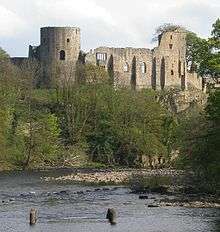Barnard Castle (castle)

.jpg)
Barnard Castle (grid reference NZ04911641) is a ruined medieval castle situated in the town of the same name in County Durham. It is a Scheduled Ancient Monument,[2] and was designated as a Grade I listed building in 1950.[3] The remains of the medieval chapel of St Margaret in the outer ward are listed as Grade II.[4][5]
A stone castle was built on the site of an earlier defended position from around 1095 to 1125 by Guy de Balliol. Between 1125 and 1185 his nephew Bernard de Balliol and his son Bernard II extended the building.[6]
In 1216 the castle was besieged by Alexander II, King of Scotland. It was still held by the Balliol family although its ownership was disputed by the Bishops of Durham. When John Balliol was deposed as King of Scotland in 1296 the castle was passed to the Bishop of Durham. Around 1300 Edward I granted it to the Earl of Warwick.[7] In the 15th century the castle passed by marriage to the Neville family.[8] In 1477 during the Wars of the Roses, Richard, Duke of Gloucester (later Richard III) took possession of the castle, which became one of his favourite residences.[9]
Over the next two centuries the Nevilles enlarged and improved the estate and created a substantial and impressive castle. However, when Charles Neville, 6th Earl of Westmorland was attainted for his leading role in the Rising of the North the Neville estates were sequestered. In 1626 the Crown sold the castle and also the Neville property at Raby Castle to Sir Henry Vane.
Vane decided to make Raby his principal residence and Barnard Castle was abandoned and its contents and much of its masonry was removed for the maintenance and improvement of Raby.[10]
The castle is in the custody of English Heritage and is open to the public. Of particular interest are the ruins of the 12th-century cylindrical tower and the 14th-century Great Hall and Great Chamber.[11]
References
- ↑ Mackenzie, James Dixon (1897). The Castles of England: their story and structure. New York: Macmillan. p. 386.
- ↑ "Barnard Castle: ringwork, shell keep castle, chapel and dovecote", The National Heritage List for England, English Heritage, 2011, archived from the original on 4 October 2012, retrieved 8 May 2011
- ↑ "The Castle:Barnard Castle", The National Heritage List for England, English Heritage, 2011, archived from the original on 4 October 2012, retrieved 8 May 2011
- ↑ English Heritage handbook: Austin D: Barnard Castle, Durham: London: 1988
- ↑ "Former chapel in outer ward of castle, with wall attached", The National Heritage List for England, English Heritage, 2011, archived from the original on 4 October 2012, retrieved 8 May 2011
- ↑ "Barnard Castle". SINE Project, University of Newcastle upon Tyne. Retrieved 2007-12-06.
- ↑ Fry, Plantagenet Somerset (1980). The David & Charles Book of Castles. Newton Abbot: David & Charles. pp. 183–184. ISBN 0-7153-7976-3.
- ↑ "Barnard Castle". University of London & History of Parliament Trust. Retrieved 2007-12-06.
- ↑ Simpson, David. "Timeline of North East History: Wars of the Roses 1455–1508". The North East England History Pages. Archived from the original on 28 December 2007. Retrieved 2007-12-06.
- ↑ "Barnard Castle". CastleXplorer. Archived from the original on 23 December 2007. Retrieved 2007-12-06.
- ↑ "Barnard Castle". English Heritage. Retrieved 2011-03-29.
Further reading
- Austin, David (2007), Acts of Perception, A study of Barnard Castles in Teesdale, Architectural and Archaeological Society of Durham and Northumberland Research Report 6, ISBN 978-0-9510388-5-7
External links
![]() Media related to Barnard Castle (castle) at Wikimedia Commons
Media related to Barnard Castle (castle) at Wikimedia Commons
Coordinates: 54°32′36″N 1°55′36″W / 54.54333°N 1.92667°W
